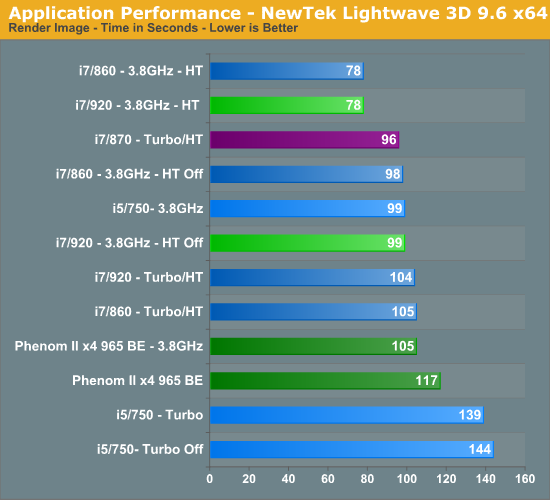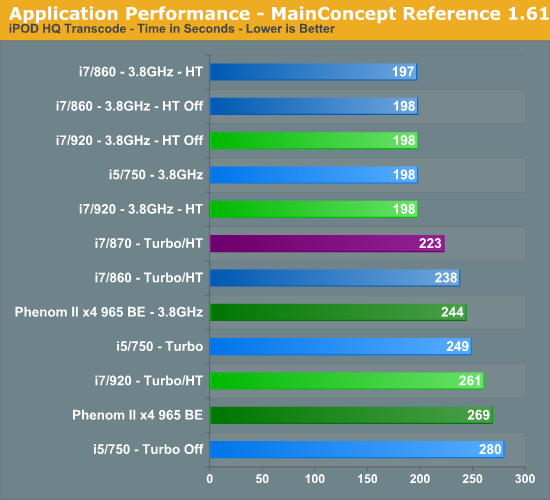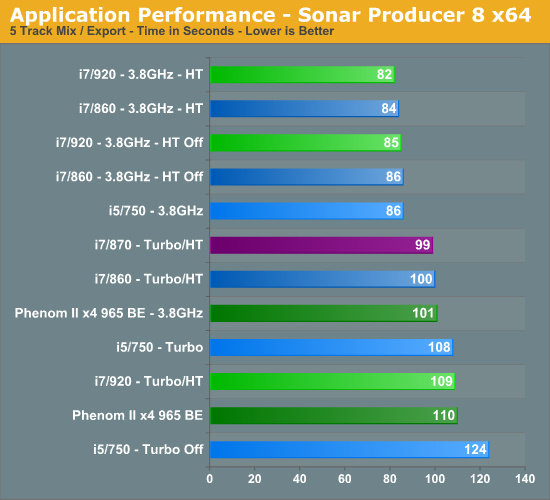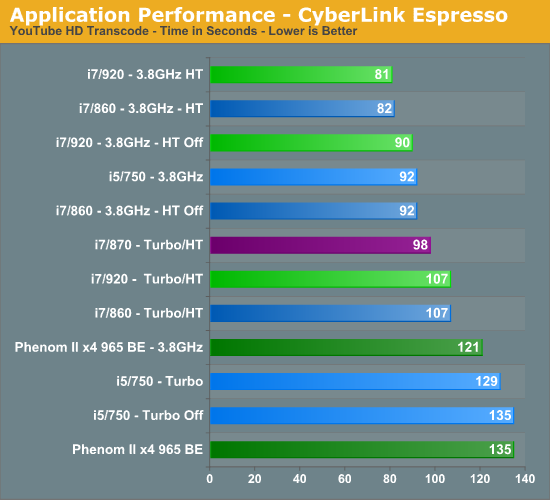i5 / P55 Lab Update - Now with more numbers
by Gary Key on September 15, 2009 12:05 AM EST- Posted in
- Motherboards
Applications-
Cinema 4D R11 x64
Cinema 4D R11 is one of our favorite programs to create high-end 3D images and animations. This particular program is sensitive to memory bandwidth and is well threaded. We track the time it takes to render a swimming pool layout.

Our i7/920 finishes first with the i7/860 just a second behind at 3.8GHz and with HT enabled. Disabling HT decreases performance 15% when these two CPUs are overclocked. The 965 BE is 27% slower at 3.8GHz than the i7/920 with HT enabled and 14% with HT disabled.
Turbo mode benefits the i5/750 greatly in this benchmark as turning it off results in the 750 being 16% slower. However, pure CPU speed allows the 965 BE to finish the benchmark about 10% quicker than the 750 with Turbo enabled and 23% with Turbo disabled with a 28% higher base clock speed. Of course, the 965 BE is 17% more expensive based on CPU cost comparisons.
LightWave 3D 9.6 x64
Another popular 3D rendering program is Lightwave 3D 9.6. In this test we time the rendering of a single frame from an office building animation. The time to render the full scene is approximately four and a half hours. This title is also well threaded and sensitive to both memory bandwidth and latency.

Lightwave also favors HT enabled processors with the 860/920 tying for first at 3.8GHz. Interestingly enough, Turbo mode on the i5/750 only offered a 3% improvement in this bench. The 965 BE scales very well as a 11% core speed increase nets a 10% improvement in the benchmark. However, the 965 BE still trails the 860/920 CPUs by 26% at 3.8GHz.
MainConcept Reference 1.61
One of our favorite video transcoding utilities is MainConcept Reference. We set our profile to iPOD HQ NTSC and then transcode a 651MB 1080P file to an iPOD HQ 34.7MB file.

HyperThreading does not make a difference in this title with the 860/920 finishing in a dead heat again. Turbo mode for the i5/750 improves its scores by 11%. Once again, the 965 BE scales very well with an 11% increase in speed resulting in a 9% benchmark improvement. Otherwise, the 965 BE trails the 860/920/750 by 29% at 3.8GHz.
Sonar Producer 8 x64
We utilize Sonar Producer extensively at home when mixing various music tracks. This test performs a complex mix of five individual tracks into a single title. We covert these tracks into a WAV format utilizing a 192kHz sample rate along with all other options enabled. This title thrives on memory bandwidth.

We finally see some separation between the 860 and 920 processors in this benchmark. Based on offline memory testing, we contribute this to the 920’s slightly better throughput under load conditions. The i5/750 performs 13% better with turbo enabled. The 965 BE performs 15% worse than the 750 at 3.8GHz.
Adobe Lightroom 2.4 x64
Lightroom is a quick and easy to use program for batch conversions on digital photos. We perform a standard conversion of 50 RAW images into the JPEG format.

HyperThreading does not matter in this title. The 920 finishes just slightly ahead of the 860. Turbo mode makes 9% difference for the i5/750, just enough to place ahead of the 965 BE at stock speeds. Once overclocked, the 965 BE is 17% slower than the 750.
CyberLink MediaShow Espresso
We transcode a 370MB 1080AVCHD file into a HD friendly file suitable for publishing on YouTube. This program features GPU hardware accelerated decoding via ATI Stream or NVIDIA CUDA but is disabled in our test routines.

Even with a 740MHz advantage in clock speed, the 965 BE is just equal to the i5/750 with Turbo disabled in this application. Obviously, it appears this particular program behaves differently on Intel processors. Even at a 3.8GHz clock speed, the 965 BE trails the i5/750 by 24%. The 920/860 processors continue to be close, even though in this application the 920 has a slight advantage.










77 Comments
View All Comments
Gary Key - Tuesday, September 15, 2009 - link
I tried renaming the exe files, no go, anyway, testing with the 4890s now and will be finished shortly so we can move on.Ocire - Tuesday, September 15, 2009 - link
Do you have a link to a recent article showing the PCIe-bandwidth usage of different games? The most recent article doing something related I could find in a quick search was some test over at Tom's hardware testing x1900xtx vs. 8800gts on different bandwidths. ;-)Renaming the .exe would be fun though to see whether some strange optimization causes this effect.
Eeqmcsq - Tuesday, September 15, 2009 - link
Thanks for the update and including Turbo off numbers for the i5 750. So at its baseline, the i5 750 is about the same or worse than the Phenom II 965. But the Turbo mode either brings the comparison closer or tips the scales in i5's favor in individual tests.As for the multitasking tests, I can understand why the i5 750, even w/Turbo, fell behind the 965. The i5 was already behind in the Lightwave 3D and Cinema 4D individual benchmarks. Combining them together would certainly "worsen" the difference, as shown by the multitasking charts.
Also, looking at the Cinema 4D test, I noticed how the Turbo boost was much less of a boost during the multitasking test compared to the individual test. This is the predicted effect as heavy multitasking pushes the CPU TDP up, leaving less room for Turbo. As a result, the i5 Turbo performance approaches that of its baseline, which is generally equal to or worse than the Phenom II 965.
Individual test, i5, lower % means better Turbo Boost effect:
Cinema 4D - Turbo finished in 84.5% of the baseline time
Lightwave 3D - Turbo finished in 96.5% of the baseline time
Multitasking test, i5:
Cinema 4D - Turbo finished in 95.3% of the baseline time
Lightwave 3D - Turbo finished in 95.6% of the baseline time
Total time - Turbo finished in 95.4% of the baseline time
So thanks again to Gary for providing the baseline Turbo numbers as well as the multitasking tests. It certainly paints a more complete picture of how to measure Turbo capable CPUs.
Requests: I'd still like to see 1x, 2x, 3x, 4x concurrent instances of the same single threaded test just to further demonstrate the variableness of Turbo compared to its baseline.
Malhandir - Tuesday, September 15, 2009 - link
One aspect of the new 1566 i5/i7 processors I love is the more intelligent turbo boost, if only because it achieves its goals so well. Have there been any indications of this being introduced into new 1366 processors in the future or are there technical limitations to its introduction keeping it to the 1156 platform? Of course any future 1366 CPUs are, well… future! But I’m interested in the answer nevertheless, since the most obvious tweak that could be done on the 1366 CPU lineup is the introduction of this core management ability.Mastakilla - Tuesday, September 15, 2009 - link
Great article once more!I think it is clear in meanwhile that the 920 offers less value for the money than a 860 in almost all the cases (except extreme benchmarking)
one use case however isn't covered yet (and that is exactly the use case that Intel said the 920 would be better for):
How do they compare with a decent OC? (meaning 4Ghz+)
Do the 920s reach 4Ghz+ easier?
I am talking about a fully stable 24/7 watercooled setup than (cause you can't decently aircool at that speed except for some short benching)
cause that is exactly what I have in mind for my next system ;)
Ann3x - Tuesday, September 15, 2009 - link
You need less volts to stabilise 920s than lynnfields (due to the pci-e stabilisation issues) therefore they run a little cooler at load therefore *should* overclock better.I say should as the lynnfields havent been around long enough to say 100%.
The opinion about the 920 being worse vfm is subjective. Atm the 920 is actually cheaper than the 860 in most places, this is offset tho by x58 vs P55. Its a close thing either way. The P55s are certainly a good bet if you dont want to push overclocks (and tweak a lot) and dont want a multi GPU setup. If you do want either of these the 920 is probably better.
Alberto - Tuesday, September 15, 2009 - link
I don't understand the botton line of the article. We can not make a comparison between available cpus and unavailable ones. Phenom II 3.4 Ghz is an exotic and hot cpu, moreover it's pretty rare to find in stores, same thing for the 3.2Ghz incarnation.A real apple to apple comparison would be between Phenom II X4 2.8/3Ghz and i5/720...both 95W and available cpus.
Gary, you can't say "in multitasking my chose is......". The real story is that you can't find a Phenom II X4 965/955 Black configured machine from a good OEM. These are exotic cpus for expensive gaming systems and AMD isn't able to make many of them.
Core i7 is everywere on big OEM sites.
Makaveli - Tuesday, September 15, 2009 - link
Alberto Who the Fu*k buys OEM systems on this site?I can find both those cpu's at any local stores in my area.
Please put the pipe down!
Alberto - Wednesday, September 16, 2009 - link
Anyway these Amd cpus are marginal and rare around the world. They don't make good revenue for a Red company like Amd. Maybe you don't have a real job, without the on site assistance of a big OEM i'd be ruined.coconutboy - Tuesday, September 15, 2009 - link
Anandtech tends to be an enthusiast site where (I assume) a heavy percentage of the readership builds their own computers by handpicking their parts. This means OEM machines are not the main focus. As for your claim that some of those AMD cpus are not easy to find, perhaps you do not live in the USA. Otherwise, I see the AMD 965, 955, 720 etc for sale at every one of the 4 retailers I just checked.newegg
mwave (I can walk into this store locally for purchases)
microcenter (another walk-in store)
zipzoomfly
I'll bet Fry's and bucketloads of other walk-in retailers offer them as well. Now we just need AMD to drop the prices to compete more evenly with Intel (although the x3 720 is quite inexpensive)